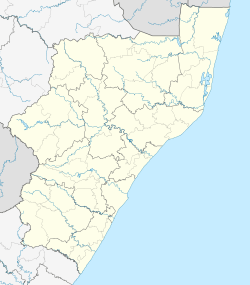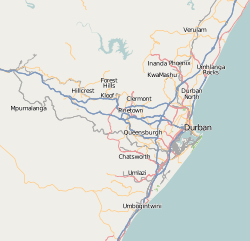KwaMashu
| KwaMashu | |
|---|---|
 KwaMashu  KwaMashu  KwaMashu
| |
|
Location within Durban  KwaMashu | |
| Coordinates: 29°45′S 30°59′E / 29.750°S 30.983°ECoordinates: 29°45′S 30°59′E / 29.750°S 30.983°E | |
| Country | South Africa |
| Province | KwaZulu-Natal |
| Municipality | eThekwini |
| Area[1] | |
| • Total | 21.47 km2 (8.29 sq mi) |
| Population (2011)[1] | |
| • Total | 175,663 |
| • Density | 8,200/km2 (21,000/sq mi) |
| Racial makeup (2011)[1] | |
| • Black African | 98.8% |
| • Coloured | 0.2% |
| • Indian/Asian | 0.8% |
| • White | 0.1% |
| • Other | 0.1% |
| First languages (2011)[1] | |
| • Zulu | 91.3% |
| • English | 2.9% |
| • Xhosa | 1.5% |
| • S. Ndebele | 1.3% |
| • Other | 3.0% |
KwaMashu is a township 32 kilometres (20 mi) north of Durban, South Africa. The name is in honour of Sir Marshall Campbell and means Place of Marshall.[2]
Arts
KwaMashu is notable for its lively performing arts scene, lively performing arts scene thrives including Maskandi, hip hop, pansula dancing, dance, drama, football. Through performance the young people of KwaMashu are raising the cultural profile of KwaMashu, aided significantly by the skills, resources and direction of eKhaya Multi Arts Centre for Arts and Performance.
The township also boasts a community radio station at the eKhaya Multi Arts Centre, called Vibe 94.70 FM, which has been in operation for more than 4 years.
History
Formerly a sugar cane plantation, KwaMashu’s name is a Zulu adaptation of Marshall which means ‘the place of Marshall’. It refers to Sir Marshall Campbell (1848-1917) the sugar cane farmer and magnate who owned the land on which KwaMashu stands and who was a member of the Legislative Assembly of the Natal colony (now KwaZulu Natal).
Marshall was the father of the late Dr Killie Campbell (Margaret Roach Killie Campbell), who had a close relationship with the Zulus living in KwaMashu. The area was successively administered by the Durban City Council and the Port Natal Administration Board and, on 1 April 1977, was transferred to the authority of the newly defined KwaZulu government.
The Group Areas Act
KwaMashu is one of the first of Durban’s townships that emerged with the implementation of the Apartheid Group Areas Act during the 1950s. The Group Areas Act was a system used by the Apartheid government to physically separate Indians, Coloureds and Africans who lived collectively in places such as Umkhumbane (Cato Manor ) an Indian township in Durban, Sophiatown in Johannesburg and District Six in Cape Town. KwaMashu became home to many of the people who were displaced through the implementation of the Act.
Durban’s rapid population growth in the 1950s intensified pressure on the Durban City Council (DCC) from the White population to clear Durban of its slum areas for security purposes and segregate urban areas. The Council was now compelled to take action on the housing of the African population of the city. Subsequently, in 1952, an emergency camp at Cato Manor was erected on a “site and service” basis in an attempt to ease the situation.
This was followed by a period of prolonged negotiation and planning for the purchase of land and the building of the KwaMashu township. The Durban City Council was required to submit their strategies to the central government for authorization. The Council was not only expected to ensure that 10 000 Indians were removed from the Duff's Road village, which fell within the boundaries of the new proposed township, but it also had to place buffer zones between African and Indian neighbourhoods and make certain that there were no connecting roads between them.
The formation of KwaMashu Township
KwaMashu township was first proposed in 1948 and finally, in June 1956, a final agreement of sale was approved by all parties at the price of £350 000 bringing to fruition the Council’s long-standing pronouncement concerning the displacement of Durban’s African residents to the north of the city. Plans for KwaMashu Township were presented to the Cato Manor Native Advisory Board for approval. Cato Manor residents who were considered illegitimate were never invited to give any input to the policy or planning of the township designated for them.
Construction of KwaMashu began in September 1957 and in November the Council started to systematically remove Africans from Cato Manor. Furthermore, 36 000 circulars were distributed in Cato Manor extolling the virtues of home-ownership, and industries were contacted and asked if they would assist in the removal of their employees.
In a competition held by The Daily News newspaper to find a proper name for the township, the name KwaMashu was suggested. This name was strongly opposed by the Native Advisory Board in Durban who favoured the names Mahlatanyane (after A.W.G. Champion - Mahlati) or Mafukuzela (afterJohn Langalibalele Dube).
The evictions
Houses in KwaMashu were erected in phases and occupied by Black people from March 1958.
By February 1962, the population of KwaMashu had reached 40 000 people, and the number rose even further when many Blacks were removed from other city locations (particularly Baumanville) to the area. In 1973, the Port Natal Bantu Affairs Administration Board took over control of KwaMashu.
The clearing of Cato Manor and the re-settlement of its inhabitants at KwaMashu was a process of great upheaval for many. The number of Blacks who disappeared during the course of the removals, estimated at 20% of the population of Cato Manor (30 000 to 40 000 people), is an indication of the number of Blacks who lived at Cato Manor without rights to urban residences. Some of these people may have vanished in order to escape resettlement at KwaMashu.
For those who moved to KwaMashu it meant increased travelling costs and inconvenience in terms of commuting to work and costly accommodation.
Independence:
References: • Peter E. Raper, New Dictionary of South African Place Names, pg.195 • Ulwazi- Sharing Indigenous Knowledge, History of Kwa Mashu, [online], Available at wiki.ulwazi.org [Accessed: 28 March 2013] • KwaZulu Natal Department of Health (2001), History of KwaMashu Community Health Centre, [online], Available at www.kznhealth.gov.za [Accessed: 28 March 2013] • EThekwini Municipality, ‘Introduction to Our Own Town- ‘KwaMashu’ [online], Available at www.durban.gov.za [Accessed: 28 March 2013] • Manson A, From Cato Manor to KwaMashu- class formation and political opposition in KwaMashu township, 1958 ”” 1980, [online], Available at www.disa.ukzn.ac.za • Inanda, Ntuzuma, KwaMashu (INK) Nodal Economic Development Profile KwaZulu Natal [online], Available at www.durban.gov.za [Accessed: 24 May 2013] • Manzi Jabulani Russell, The manifestation of apartheid egacy on housing within the Durban Metropolitan region ”“ A case of KwaMashu Township, (Honours Thesis), University of Zululand Department of Geography, December 1994
Civil Society
The Abahlali baseMjondolo movement is very prominent in the informal settlements and transit camps in the KwaMashu area. They claim to have membership in K-section, Siyanda A, B, and B5, and in two Richmond Farm transit camps.[3][4][5]
Public schools
- Bhekilanga Lower Primary
- Buhle Higher Primary school
- Daluxolo Lower Primary
- EThekwini Junior Primary
- Dumani Lower primary School
Gugulethu Lower Primary School
- John Dube High School
- Khethamahle Higher Primary School
- Khuphukani Lower Primary School
- Kwesethu High School
- Mukelani Higher Primary
- Mzuvele High School
- Ndabazezwe Lower Primary School
- Ngazane Lower Primary
- Nhlakanipho High School
- Nkulisabantu Lower Primary
- NqabakaZulu Comprehensive High School
- Phakama Higher Primary
Phumelela Higher Primary
- Phuthumani Primary
- Shayamoya Lower Primary School
- Sibonelo High School
- Sivananda FET School
- Thandimfundo Lower Primary School
Thandukwazi Higher Primary School
- Tholamandla Higher Primary School
- Zakhe High School
- Dukemini Lower Primary School
- Zeph Dlomo High School
- Zamokuhle Lower Primary School
Related Townships
Notable People from KwaMashu
- Henry Cele, actor
- Leleti Khumalo, actress
- Thenjiwe, Stand up comedian and actress
- Tu Nacho
- Siyabonga Nomvethe, football player
- Jeff Radebe, politician
- Zakes Bantwini, musician, record producer
- Jacob Zuma, President of the Republic of South Africa
- Estil Mpunzana
- Riky Rick, hip hop recording artist and record producer
- Nomzamo Mbatha, actress
- Deborah Fraser, gospel singer
- Buyi Zama
Avante gospel group Sipho Mbhele -siphop music Zakwe the rapper Duncan Khulubuse Zuma Mabheleni Ntuli NDABA "Mshefane" Mhlongo
KwaMashu on film
- 2008 film "Kwa Mashu: Still my Home" by director Owen 'Alik Shahadah in conjunction with South African arts centre Ekhaya Multi Arts Centre under K-CAP with Edmund Mhlongo (Executive Producer), based in KwaMashu. The film is about the history of the township.[6][7]
References
- 1 2 3 4 "Main Place KwaMashu". Census 2011.
- ↑ Raper, R.E. Dictionary of Southern African Place Names. Human Sciences Research Council (South Africa).
- ↑ World Habitat Day. Rajpatel.org. Retrieved on 2012-02-10.
- ↑ The ANC's coup in Kennedy Road. Politicsweb.co.za. Retrieved on 2012-02-10.
- ↑ Siyanda (A & B) March, Siyanda to Downtown KwaMashu, 14 April 2009. Abahlali.org. Retrieved on 2012-02-10.
- ↑ "KwaMashu (2008)". IMDb. 1 August 2008. Retrieved 6 September 2015.
- ↑ "STILL MY HOME – KwaMashu The Official Film Site". stillmyhome.com. Retrieved 6 September 2015.
.svg.png)